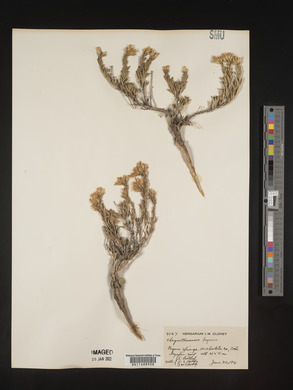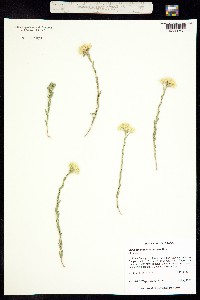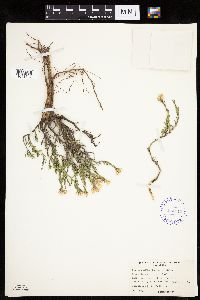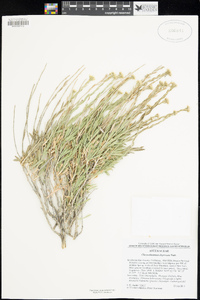Chrysothamnus depressus
|
|
|
|
Family: Asteraceae
Long-Flower Rabbitbrush, more...longflower rabbitbrush, dwarf rabbitbrush
[Bigelowia depressa (Nutt.) A. Gray, moreEricameria depressa (Nutt.) L.C. Anders., Linosyris depressa (Nutt.) Torr.] |
Shrubs, 10-50 cm; woody, highly branched caudices, proximal branches decumbent, bark tan to gray, flaky with age. Stems green, becoming whitish tan, ± ridged from leaf bases, densely puberulent. Leaves erect or closely ascending; sessile; blades with evident midnerves, linear to oblanceolate or narrowly oblong, 7-30 × 1.5-7 mm, flat to keeled, apices acute (often apiculate), faces glabrous or puberulent, sometimes sparsely stipitate-glandular. Heads in densely cymiform arrays, not overtopped by distal leaves. Involucres obconic, 9-15 × 3-5 mm. Phyllaries 20-25 in 4-6 series, in 5 strong vertical ranks, tan, often with green and/or purplish markings, midnerves evident throughout and ± expanded apically, lanceolate to elliptic, 3-8 × 0.5-1.5 mm, unequal, outer often herbaceous, inner scarious, strongly keeled, apices acute to acuminate, flat, faces puberulent. Disc florets 5-6; corollas 7-11 mm, lobes 1-2.1 mm; style branches 2.4-3.3 mm, appendages 1.5-2 mm. Cypselae tan, subcylindric (tapering proximally), ± flattened, 5-6.5 mm, faces glabrous, sparsely glandular distally; pappi whitish tan, 5.5-7.5 mm. 2n = 18. Flowering late summer-fall. Dry canyons and rocky crevices; 1000-2700 m; Ariz., Calif., Colo., Nev., N.Mex., Utah. Common Name: longflower rabbitbrush Duration: Perennial Nativity: Native Lifeform: Shrub General: Shrub, 10-50 cm (0.3-1.6 ft) tall; stems erect to ascending, greenish, becoming whitish tan with age, densely puberulent; branches rigid, the lower ones decumbent; twigs herbaceous, finely puberulent; caudex highly branched. Leaves: Cauline, alternate, simple, linear-oblanceolate, narrowly oblong or elliptic-oblong, mostly 0.7-2 cm long, 1-4 mm wide, erect to closely ascending, surfaces glabrous or puberulent, sometimes with stalked glands, margins entire, apex obtuse to acute, the upper cauline blades often tipped with a sharp point; blades sessile. Flowers: Heads numerous, clustered in dense cyme-like arrays at the branch apices; involucre obconic, 9-13 mm long; involucral bracts in 4-6 series, strongly aligned in 5 vertical ranks, strongly keeled, tan, often tinged greenish or purplish, apex acute to acuminate, usually awn-tipped; disk flowers only, 5-6, 7-9.5 mm long, yellow. Fruits: Achene, 5-7 mm long, 4-angled, slightly flattened, tan, glabrous and sparsely glandular towards the apex; pappus of numerous minutely barbed whitish tan bristles. Ecology: Found in dry, open habitats, rocky slopes, crevices, canyons from 5,000-9,000 ft (1524-2743 m), flowers July-October. Distribution: Apache, Coconino, Mohave, and Navajo counties; southwestern U.S. Notes: Chrysothamnus molestus (Arizona rabbitbrush) is smaller (8-20 cm tall), with leaves linear to narrowly elliptic, the surfaces moderately puberulent and bearing stalked glands, and the involucral bracts with acute to rounded tips. It typically occurs in pi-on-juniper communities, in rocky and limestone soils. Chrysothamnus viscidiflorus (yellow rabbitbrush) is distinguished by a taller growth form (10-120 cm tall), leaves ascending, spreading or deflexed, linear to filiform or lanceolate, and achenes moderately to densely pubescent. Five subspecies occur in Arizona; of these, ssp. lanceolatus, ssp. planifolius, ssp. puberulus, and ssp. viscidiflorus are reported as occurring in our elevational range. Ethnobotany: The Hopi use C. depressus for prayer stick decorations. The Navajo use it to facilitate childbirth and delivery of the placenta. Editor: Springer et al. 2011 |
|
|
|





























































































